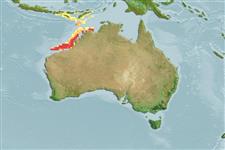Elasmobranchii (hajar och rockor) (sharks and rays) >
Myliobatiformes (Stingrays) >
Dasyatidae (Stingrays) > Dasyatinae
Etymology: parvonigra: Name from Latin 'parvus' for little and 'nigra' for black, refers to its resemblance to a larger Australian species Dasyatis thetidis..
More on authors: Last & White.
Environment: milieu / climate zone / depth range / distribution range
Ekologi
marina; brackvatten bentopelagisk; djupintervall 60 - 185 m (Ref. 114953). Tropical; 20°N - 20°S, 115°E - 128°E (Ref. 114953)
Eastern Indian Ocean and Western Central Pacific: Philippines to north-western Australia.
Length at first maturity / Size / Vikt / Age
Maturity: Lm ?, range 35 - ? cm
Max length : 51.0 cm WD hane/ej könsbestämd; (Ref. 114953)
This demersal species lives offshore on continental shelf, probably occasionally shallower; caught incidentally in trawl and net fisheries; llfe history unknown (Ref. 114953). Maximum length for females of similar form, possibly up to 49.8 cm WD (Ref. 76959).
Life cycle and mating behavior
Könsmognad | Reproduktion | Lek | Ägg | Fecundity | Larver
Last, P.R. and W.T. White, 2008. Dasyatis parvonigra sp. Nov., a new species of stingray (Myliobatoidei: Dasyatidae) from the tropical eastern Indian Ocean. In Last, P.R., White, W.T. & Pogonoski, J.J. (eds.): Descriptions of New Australian Chondrichthyans. CSIRO Marine and Atmospheric Research Paper no. 22. (Ref. 76959)
IUCN Red List Status (Ref. 130435)
Threat to humans
Harmless
Human uses
Ytterligare information
Age/Size
Tillväxt
Length-weight
Length-length
Length-frequencies
Morfometri
Morfologi
Larver
Larvdynamik
Rekrytering
Abundans
BRUVS
referenserVattenbrukVattenbruksprofilAvelslinjerGenetikElectrophoresesÄrftlighetSjukdomarBehandlingNutrientsMass conversion
MedarbetareBilderStamps, Coins Misc.LjudCiguateraHastighetSimsättGälytaOtolithsHjärnstorlekSyn
Verktyg
Special reports
Download XML
Internet-källor
Estimates based on models
Preferred temperature (Ref.
123201): 19.6 - 23, mean 21.5 °C (based on 8 cells).
Phylogenetic diversity index (Ref.
82804): PD
50 = 0.5010 [Uniqueness, from 0.5 = low to 2.0 = high].
Bayesian length-weight: a=0.00646 (0.00265 - 0.01571), b=3.06 (2.86 - 3.26), in cm total length, based on LWR estimates for this (Sub)family-body shape (Ref.
93245).
Trofisk nivå (Ref.
69278): 3.7 ±0.5 se; based on size and trophs of closest relatives
Fishing Vulnerability (Ref.
59153): Very high vulnerability (90 of 100).
